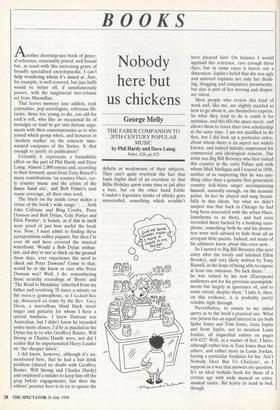BOOKS
Nobody here but us chickens
George Melly
THE FABER COMPANION TO 20TH-CENTURY POPULAR MUSIC by Phil Hardy and Dave Laing
Faber, £20,.pp.875
Another doorstop-size book of gener- al reference, reasonably priced, well bound but, as usual with this increasing genre of broadly specialised encyclopaedia, I can't help wondering whom it's aimed at. Jazz, for example, is well-covered, but jazz buffs would be better off, if simultaneously poorer, with the magisterial two-volume set from Macmillan.
That leaves memory lane addicts, rock journalists, pop sociologists, reference lib- raries, those too young to die, too old for rock'n roll, who like an occasional fix of nostalgia or tend to get into furious argu ments with their contemporaries as to who joined which group when, and lecturers in 'modern studies' on the concrete time- warped campuses of the Sixties. Is that enough to justify its publication?
Certainly it represents a formidable effort on the part of Phil Hardy and Dave Laing. Almost 2,000 entries and, according to their forward, apart from Tony Russell's many contributions `on country blues, ear- ly country music and the artists of the dance band era', and Bob Fisher's soul music coverage, all their own work.
The blurb on the inside cover makes a virtue of the book's wide range: '. . . both John Coltrane and Bing Crosby, Peter Dawson and Bob Dylan, Cole Porter and Elvis Presley', it boasts, as if this in itself were proof of just how useful the book was. Now, I must admit to finding these juxtapositions rather piquant, but then I'm over 60 and have covered the musical waterfront. Would a Bob Dylan enthus- iast, and they're not so thick on the ground these days, ever experience the need to check out Peter Dawson? Come to that, would he or she know or care who Peter Dawson was? Well, I do, remembering those scratchy recordings of 'Boots' and The Road to Mandalay' inherited from my father and revolving 78 times a minute on the nurse, y gramophone, su 1 luuked him up, dist' acted en route by the Rev. Gary Davis, a marvellous blind black street singer and guitarist for whom I have a special fondness. I knew Dawson was Australian, but I didn't know he recorded under many aliases; I'd be as puzzled as the Dylan fan as to who Geoffrey Baxter, Will Strong or Charles Handy were; nor did I realise that he impersonated Harry Lauder on `the cheaper labels'.
I did know, however, although it's un- mentioned here, that he had a bad drink problem (shared no doubt with Geoffrey Baxter, Will Strong and Charles Hardy) and employed a minder to keep him off the grog before engagements; but then the editors' practice here is to try to ignore the defects or weaknesses of their subjects. They can't quite overlook the fact that Janis Joplin died of an overdose or that Billie Holiday spent some time in jail after a bust, but on the other hand Eddie Condon's legendary intake of whisky goes unrecorded, something which wouldn't
have pleased him! On balance I would applaud this reticence, rare enough these days, but in some cases it leaves out a dimension. Joplin's belief that she was ugly and unloved explains not only her drink- ing, drugging and compulsive promiscuity, but also is part of her moving and desper- ate talent.
Most people who review this kind of work and, like me, are slightly puzzled as how to go about it, are themselves experts. So what they tend to do is comb it for mistakes, and this fills the space nicely, and allows them to boost their own scholarship at the same time. I am not qualified to do that, but I did look up a particular entry, about whom there is an aspect not widely known, and indeed initially suppressed for commercial and ideological reasons. The artist was Big Bill Broonzy who first visited this country in the early Fifties and with whom Mick Mulligan and I toured in 1958, neither of us suspecting that he was any- thing other than a genuine first generation country folk-blues singer accompanying himself, naturally enough, on the acoustic guitar. In fact he played and sang beauti- fully in that idiom, but what we didn't suspect was that back in Chicago he had long been associated with the urban blues, (anathema to us then), and had even recorded them backed by a honking saxo- phone, something both he and his promo- ters were well advised to hide from all us arrogant little purists. Indeed, not many of his admirers know about this even now.
So I turned to Big Bill Broonzy (the next entry after the lovely and talented Elkie Brooks), and very likely written by Tony Russell, in the hope of being able to expose at least one omission. No luck there: . . he was valued by his new (European) audiences not for his previous accomplish- ments but largely in ignorance of, and to some extent, despite them.' I take it, then, on this evidence, it is probably pretty reliable right through.
Nevertheless, to return to my initial query as to the book's practical use. What one person has an equal interest in say both Spike Jones and Tom Jones, Janis Joplin and Scott Joplin, not to mention Louis Jordan, all sequential entries on pages 419-422? Well, as a matter of fact, I have, although rather less in Tom Jones than the others, and rather more in Louis Jordan, having a particular fondness for his 'Ain't Nobody Here But Us Chickens', so I suppose in a way that answers my question. It's an ideal bedside book for those of a certain age with wide musical or extra- musical tastes. Bit heavy to read in bed, though.


















































 Previous page
Previous page